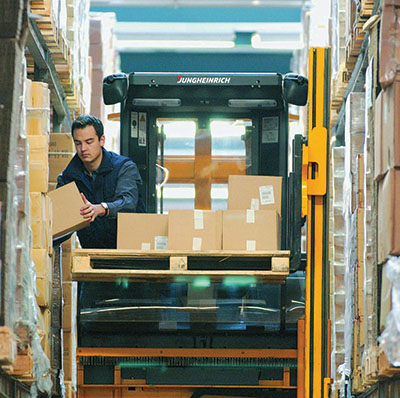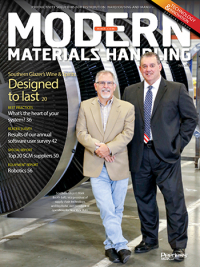Lift Truck Tip: Feeling the squeeze in narrow aisle forklifts
Narrow and very narrow aisles offer many of the benefits of automation at a lower cost and complexity, but they also present users with a set of potential pitfalls.
In recent years, more companies are looking to best use their existing space to avoid taking on the expense, time and headaches associated with expansion or relocation. The trend is fed by the ongoing proliferation of stock keeping units (SKUs), which can significantly disrupt productivity as well as space utilization. In this climate, narrow and very narrow aisle (VNA) solutions have gained ground as less costly ways to achieve greater storage density. However, to ensure throughput is also preserved in these transitions, several important considerations need to be addressed.
As compared to the conventional aisle width of 11 feet or larger, narrow refers to aisles between 8 and 10 feet in width, where primarily reach trucks are used. VNA includes aisles between 5.5 and 6.5 feet wide and as such require more specialized equipment like turret trucks and high- or low-level orderpickers. Perry Ardito, general manager of warehouse products for Mitsubishi Caterpillar Forklift America, says many customers are opting for VNA for maximum density. He cites year-over-year growth of nearly 45% in VNA systems and related equipment.
“Turret trucks significantly boost density, productivity and selectivity in a way similar to automated systems,” he says. “And, like automated systems, customers are looking for the benefits of increased height. Our current maximum lift height is 708 inches, and we’re looking at going above 800 inches based on customer requests. I would estimate lift truck heights across the industry have increased at least 25% from just five years ago.”
Although less complex and costly than automation, the process of squeezing more into less space will still create some disruption in the short term, Ardito cautions. A VNA customer will need to acquire additional racking, empty existing racks and find a temporary home for inventory. After the new rack is installed, it is critical to instill discipline in operators who will now have only inches of clearance in an aisle.
“Product has to be put away the right way every time, since you can’t have loads stacked or placed improperly,” he says. “The equipment is also so specialized that it needs to be maintained very thoroughly, which also promotes discipline in these operations.”
Aside from new equipment, a move to narrow or VNA setups also has a significant IT component. It’s important to effectively manage product storage with effective slotting, Ardito says, for example by planning for fast-movers to be spread across multiple aisles or kept close to aisle ends and lower locations.
Under the IT umbrella, it is also valuable to have systems in place to provide pickers with accurate information. Ardito notes a strong movement toward real-time information, sent for instance by Wi-Fi to terminals mounted on forklifts. “More companies are getting away from paper-based picking in favor of radio data terminals (RDT), which can further boost productivity,” he adds.

Article Topics
Lift Truck Tips News & Resources
Overlooked no more: The importance of lift truck inspections Lithium transition: It’s all about the outcomes Safety for automatic guided vehicle (AGV) environments Assessing the move to lithium Leasing’s fleet management upside Managing for lift truck operator safety Narrow aisle success: Think systems, then trucks More Lift Truck TipsLatest in Materials Handling
Registration open for Pack Expo International 2024 Walmart chooses Swisslog AS/RS and software for third milk processing facility NetLogistik partners with Vuzix subsidiary Moviynt to offer mobility solutions for warehouses Materials Handling Robotics: The new world of heterogeneous robotic integration BSLBATT is looking for new distributors and resellers worldwide Lucas Watson appointed CSO for Körber’s Parcel Logistics business in North America Hyster recognizes Dealers of Distinction for 2023 More Materials HandlingAbout the Author
Subscribe to Materials Handling Magazine

Find out what the world's most innovative companies are doing to improve productivity in their plants and distribution centers.
Start your FREE subscription today.
April 2024 Modern Materials Handling

Latest Resources












